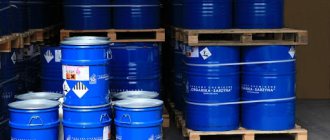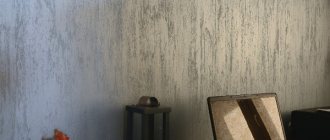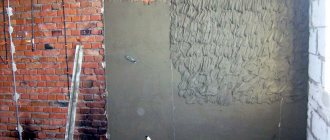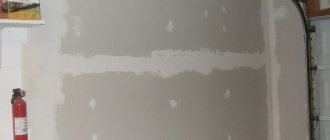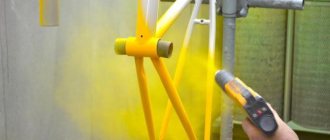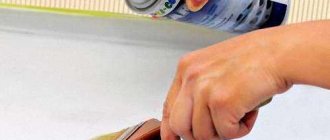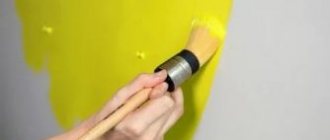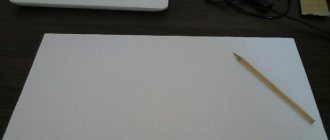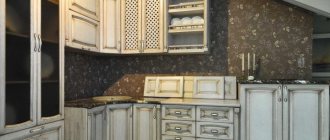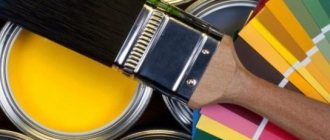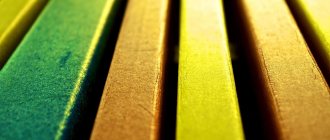In order to attach a picture, a photograph without a frame or an applique to a flat wall, there is no longer any need to nail these decorative pieces, hold them in place with tacks or glue them with glue. Magnetic paint applied to walls, after drying, will create a surface area to which magnets will be easily attracted. Due to this, on the surfaces of various surfaces painted with this coating, it will be possible to mount photographs, drawings, and various decorations on a magnetic basis.
Purpose of the material
The fashion for removable decorative elements, pictures and photographs on the walls, dictated the need for a material capable of holding all these interesting details on the surface of the walls, giving the interior a lively and lived-in look.
There is no magic here. Paints that are applied to the area of walls allocated for decoration with illustrative materials and children's drawings contain iron particles. This building material is often also called magnetic soil. This composition is used to coat surfaces:
- concrete,
- plywood sheets,
- wooden surface of boards,
- painting of fibreboard, chipboard, gypsum fiberboard, gypsum board.
After applying iron-containing primer, the surface treated with it acquires magnetic properties. Thanks to this, magnets are attracted to the plane of the walls and easily held on it.
This paint can be used to create magnetic sections of walls:
- in cafes and at personal workplaces in offices and offices of various organizations,
- kindergartens and schools (for covering boards intended for demonstrating visual educational material),
- at home (in kitchens, children's rooms).
A primer that has magnetic properties can be pasted over with wallpaper, but its ability to attract magnets will not be lost. Such compositions are used as a basis for covering a marker board.
It was as if they knew we would get to the magnetic paint tests and were patiently waiting for the results. Or they unobtrusively pushed him towards it. In any case, welcome: a review of magnetic paints based on practical testing.
What it is?
First, let's talk about magnetic paint. This is a base paint coating that contains metal particles - they create the effect of “magnetism”. Magnetic paint is applied to walls, floors, furniture and creates functional surfaces to which magnets are attached. Used in offices, public and creative spaces, children's rooms and educational institutions. On top of a layer of magnetic paint, you can apply finishing paint of the desired color or wallpaper, while the surface does not lose its magnetic properties.
Board vs Paint
At the beginning of testing, we decided to figure out what was more profitable and functional - a magnetic coating, a magnetic or cork board. I didn’t have to think long: paint, paint and paint again. The paint allows you to choose the area of the magnetic surface, its shape and even color. Of course, it’s faster to buy a board, but that’s where its advantages end.
List of participants
We have selected popular and proven magnetic paints in Russia. The testing participants were: Active Wall from Magnetic Company, MagnetPaint from MagPaint, Dupli-color from Motip Dupli, Tikkurila and Rust Oleum paints from the same companies.
The geography of coatings turned out to be extremely wide: Active Wall and MagnetPaint are produced in the Netherlands, Dupli-color in Germany, Rust Oleum from the USA, Tikkurila from Finland. Initially, Russian paint was supposed to be included in the review, but it did not pass the tests: after application, yellow spots appeared on the coating, and the paint, as it turned out, was rusting.
All coatings from the review are certified, comply with safety requirements for paint and varnish products and are officially sold in Russia. We just have to figure out their pros and cons.
Comparative analysis
Let us immediately note that we compared the results of painting test samples and the characteristics declared by the manufacturers. We didn’t find any significant differences, so feel free to buy the magnetic paint you like from official dealers and don’t be afraid that your expectations won’t match reality.
Tara-jar
You may ask: “What difference does it make what container the paint is sold in? » Significant, because for a home you need a small jar, but for an office a large one is preferable. Therefore, the more packaging the paint manufacturer makes, the better.
Tikkurila is sold only in a 0.5 liter jar - this is not very convenient even for homework. Rust Oleum's 1-liter jar is already better, but having no alternative is worse than choice. Dupli-color is better suited for the office: it is sold in containers of 1 and 2.5 liters.
The leaders are MagnetPaint and Active Wall coatings, which have 0.5 l, 1 l, 2.5 l and 5 l cans. You can choose the ideal volume for both a small wall in a nursery and a huge surface in a school or office.
Everyone is equal, as if by choice
Magnetic paints are intended exclusively for interior use, are single-component and do not require special preparations before use. Just stir thoroughly to evenly distribute the metal particles.
To attract magnets through a layer of finishing paint or wallpaper, magnetic paint is applied in 2-3 layers. When painted, the tested samples gave off a slight odor that did not require additional ventilation.
To create a magnetic marker or magnetic slate board, use marker or slate paint as a finishing layer. This will create a multifunctional coating on which magnets are attached and you can write with markers or crayons.
Excellence student
According to some characteristics, MagnetPaint magnetic paint differs from all others. It is applied both with a roller and a spray gun, the rest - exclusively with a roller. And only MagnetPaint can be diluted with water if necessary. These are far from the most important indicators, so let’s just note the fact itself.
Colored shelter
MagnetPaint, Tikkurila, Active Wall and Dupli-color paints are gray, Rust Oleum is black, and it is more difficult to hide under the finishing layer. If you want a black magnetic board, choose Rust Oleum; in other cases, other colors are more practical.
Layer by layer
Each layer of magnetic paint requires a certain amount of drying time. A layer of MagnetPaint and Active Wall paints dries for 4 hours, the third layer is left for 24 hours. With Dupli-color, the layer dries for 4 hours, the last layer is left for 6 hours. With Rust Oleum, each coat takes 30 minutes to dry and the topcoat is applied 4 hours after the third coat. With Tikkurila paint, each layer dries within 24 hours.
Total time required for drying when painting in 3 layers: Rust Oleum - 5 hours, Dupli-color - 14 hours, MagnetPaint and Active Wall - 32 hours, Tikkurila - 72 hours.
Rust Oleum is the sole leader, Dupli-color is also quite good. Tikkurila is an outsider.
Coverage area
The leaders in coverage area are Active Wall, MagnetPaint and Dupli-color. If you follow the standard instructions and paint the surface in 3 layers, one liter of these paints will be enough for 2 m². Rust Oleum and Tikkurila results - 1 liter per 1.5 m².
Name the price
One of the most important indicators is the price per square meter of coverage. MagnetPaint is in the lead - 1220 rub./m². In second place is Dupli-color - 1450 rub./m², followed by Active Wall - 1625 rub./m². Tikkurila - 1900 rub./m² and Rust Oleum - 1993 rub./m² close the price table.
The difference in price between the first and last places is almost twofold: this obviously does not count for Tikkurila and Rust Oleum paints.
Positive traits
Primers with magnetic properties have a number of advantages:
- these building materials are completely free of unpleasant odors,
- are not poisonous, therefore they can be used in medical and educational institutions,
- comply with fire safety standards,
- belong to environmentally friendly building materials, do not have a harmful effect on the health of people and animals,
- have increased adhesion to any surfaces,
Such soils have special properties. Paints can dampen electromagnetic radiation from household appliances:
- TVs,
- microwave ovens,
- computers.
What is magnetic paint - areas of application
Magnetic primer is an alternative to magnetic boards; it is much easier to cover large areas with it if you want to create an entire magnetic wall. The composition uses small metal particles to achieve the effect of attracting metal. Can be used for both walls and furniture.
Magnetic primer can be used in large institutions and at home. After all, using magnets as a fastening element is much more convenient than using screws and nails, and the surface suffers less.
It should be noted that magnetic soil can be covered with wallpaper on top, while the magnetic effect will be maintained. It is used in educational institutions, because then you can leave important information for a long time, whereas standard boards, which are created only for writing on them with crayons or markers, cannot boast of this.
Application is in demand in institutions where information is frequently updated, such as cafes, offices and others. At home, this is a great option to create a place for children where they can post notes that interest them at the moment, draw, and more.
Application is in demand in institutions where information is frequently updated, such as cafes, offices and others.
Advantages and disadvantages
To decide whether to paint your walls with a magnetic primer, you should consider the positive and negative aspects of the product. The advantages include:
- Non-toxic;
- Fire safety;
- Has high rates of adhesion to different substrates;
- Does not emit an unpleasant odor;
- This is a more economical option compared to large magnetic boards.
One of the important advantages is the suppression of electromagnetic waves emanating from various devices.
The paints also have a downside: the range of paint colors is small, but if necessary, you can paint the wall with acrylic paint.
It has high levels of adhesion to various substrates.
Application of material
Application of magnetic material to a selected area of the surface must be done in the following sequence:
- Clean the wall (or any other surface) of all types of dirt. If its surface is contaminated with remnants of old peeling varnish or paint, then the particles of the paint layer must be cleaned with a solvent.
- Then the metal/wooden surface or product can be washed using any suitable detergents. Now you need to let the surface dry.
- If there are unevenness or defects on the walls or boards, they must be carefully repaired and puttied. A well-prepared surface should be perfectly smooth.
- After drying, the cleaned surface is coated with deep penetration primers. To do this, the material must be thoroughly mixed before use.
- Primers that can penetrate deep into the pores of the base material are applied in two or three layers, making sure to allow the primed walls to dry after each coating.
- Iron-containing paint is applied to the last layer of deep penetration primer.
Types of paints with a magnetic effect
Today, the building materials market offers a wide range of magnetic paints. Everyone can find the option that suits them best. As an example, consider several popular brands of this paint. Tikkurila Magnetic is a slate composition from a Finnish manufacturer that provides the texture of a wooden board. This composition is often used in schools and kindergartens. It is applied to walls to create an alternative to the classic chalkboard. It’s also convenient to renew old school boards by giving them additional magnetic properties. A generally recognized advantage of this brand is its excellent wear resistance. The manufacturer guarantees that the magnetic layer does not wear off after 5 thousand brushing treatments. In addition, the paint is washed off perfectly and without loss. It should be remembered that it is better to apply the paint in more than one layer. In addition, the composition should be diluted to reduce material consumption. It is better to apply the solution with a short-nap roller so as not to waste too much paint. The Magpaint brand is relatively new to the CIS countries. He has already managed to collect a lot of positive reviews, including from professional finishers. One liter of composition is enough to cover two square meters. It is recommended to apply 3 layers to obtain a high-quality painted surface. Experts call the advantage of Magpaint the ability to use this paint even on surfaces of the most complex profile, including:
- on drywall;
- on wood;
- on polymers;
- on metal.
Please note: Drying time for primer on various surfaces before applying paint.
The budget brand Siberia is a slate coloring composition with a metallic shine effect Siberia. By treating this or that surface with this paint, you will get a surface on which it is convenient to draw not only with regular chalk, but also with slate chalk. But the main advantage of this composition is the greatest durability of all those considered; the paint can withstand up to 10 thousand brushings. In addition, the mixture contains a protective ingredient that prevents the growth of fungus in a humid atmosphere. For this reason, Siberia is suitable even for relatively damp rooms (bathroom, kitchen), as well as for external walls.
Magnetic paint SIBERIA
Magnetic paint MagPaint
How to make soil with magnetic properties at home
To make your own magnetic slate easel for your children or a marker board for your office, nursery or kitchen, you can make your own iron-containing soil.
This is not as difficult to do as it might seem, since it is based on an acrylic primer to which small particles of metal have been added.
To make paint with magnetic properties with your own hands, you need to prepare:
- acrylic paint of any color (the quantity depends on the surface area; 250 ml is enough to make one magnetic marker board),
- sand-free cement (2 tablespoons),
- metal dust,
- container for combining ingredients,
- a whisk for mixing paint (if you don't have one, a large spoon will do)
Making your own paint
Not everyone is happy with magnetic paint due to its price. The price of one can starts from 1000 rubles. and can climb quite high, depending on the ingredients. And 1 liter of such paint is enough to treat no more than 2 square meters of surface. Consequently, many are interested in: is it possible to save money?
1 recipe
Yes, such a method exists. There is a completely economical recipe for making your own magnetic paint. To do this you will need acrylic paint in the color you like. Cement-based construction mixture should be poured into it. The ratio is as follows: for a glass of paint, two tablespoons of the mixture. This method will help you create homemade chalkboard paint that imitates the texture of a classic chalkboard. But so far our paint has not acquired magnetic properties. To ensure these, you should carefully mix small shavings from any inexpensive metal into your composition. And the smaller the particles, the better the quality of the magnetic paint.
Universal cement mixture
Metal shavings Pay attention to: Facade paint, properties, how to choose and painting process.
2 recipe
But the second method of creating a magnetic painted surface is considered even less expensive:
- prepare a varnish based on polystyrene foam dissolved in acetone
- add crushed metal filings to this varnish;
- Apply the resulting composition in several layers to the target surface;
- as a finishing layer, cover the metallized layer with regular varnish and let dry;
- Paint the magnetic layer with regular enamel of the desired color.
Metal filings are needed to create magnetic paint
Preparing polystyrene foam varnish
Recipe for paint containing iron particles
In a bowl, small saucepan or jar, you need to mix 2 tablespoons of cement, the same amount of metal dust and one cup of paint. Mix everything thoroughly until the mass is homogeneous. This completes the process of making a primer with magnetic properties.
By creating a wall surface or a marker board with magnetic properties, you can realize more than one bold design idea. Such areas of the plane can be used for gluing various decorative elements and photographs (for example, in a photo studio and hairdresser's). In a nursery, such a wall will allow the child to leave notes with daily recommendations.
Magnetic wall
To get a magnetic wall, use one of two methods - magnetic paint or magnetic primer. Their magnetic properties lie in the fact that small metal shavings are mixed into the composition. It’s better to mention this, because I know from experience: if a wall is made in a nursery, many mothers have concerns about the safety of the solution, because a magnetic wall produces a large magnetic field, and mothers are afraid of any fields. Metal shavings attract magnets (or rather, vice versa), but they themselves are not magnets.
Magnetic paint is limited to white and dark gray; this is already a fine coating, but it is still possible to use 2-3 layers of regular paint. If there is no goal to make a white or dark gray magnetic wall, it is much more rational to use magnetic primer; it is colorless and is used as a substrate for the final coating. There may be paint or even thin wallpaper on top.
Important tip: Follow the application instructions carefully. The coating is applied in several layers; it is imperative to maintain the minimum required volume of paint for the specified wall area. It’s better to apply even a little more, otherwise the effect will be weaker (only light flexible magnets will hold on, heavy ones will fall off).
slate wall
The graphite wall is a fairly well-known solution. This is a special paint (commonly called chalkboard paint), green or black, of which only black is usually used. Allows you to make a large chalkboard out of a wall.
The magnetic layer is the substrate, and the marker and graphite layer are the top layer: from these coatings you can make two more solutions for the wall:
I have two favorite uses for a magnetic wall: the nursery and the kitchen. In the kitchen to unload the long-suffering refrigerator, and in the nursery in order to make the child’s room as flexible as possible (the child grows quickly, his interests change quickly, he can easily change his environment with posters, photos, drawings, anything that a magnet can hold ). In general, the nursery is a separate, very painful topic that is worth writing about separately.
Marker coating and a slate wall can also be used in a nursery, but this is for the neatest and most responsible. Leaning on chalk and markers can easily stain your clothes or transfer dirt to other things. It is much more interesting to use this technique in hallways (at the entrance, for notes), in the kitchen, and in offices. It is worth starting from the function: who, how and why will use the wall.
Source
Use Cases
MagPaint magnetic wall covering dries very quickly and the painted surface is ready for use almost immediately. This is the only covering on which you can stick wallpaper on top - the wall will retain its “attractiveness” to magnetized objects. That is, the painted area does not necessarily have to stand out against the general background - it can be hidden, but at the same time various objects and accessories can be fixed on the wall. Designers actively use this property in their design: an unusual wall becomes the backdrop for meaningful details of the decor.
Recipe for obtaining magnetic dye
In a prepared container (jar, pan, bowl), mix cement (2 tablespoons) with metal dust (the same amount) and a glass with a dye.
Everything needs to be mixed well until you get a mass of homogeneous consistency. In principle, that’s all, the process of obtaining the magnetic composition is completed.
Where can I find special dust? It is always available in factories that specialize in the manufacture of various parts for equipment.
You need to be very careful with steel dust so that it doesn’t get into your eyes or onto your skin.
After receiving the mass, you can begin making a board with magnetic properties:
- You need to put a layer of primer mixture on the base.
- After drying (you need to leave the surface for a day), apply a magnetic agent with a roller or brush.
- To make the board easy to care for and easy to wipe, it can also be coated with a special marker product.
This is how you can easily make a magnetic board yourself with features, and on which you can also draw.
It makes it good to plan your day, write down your tasks and just have fun drawing different pictures.
Application technology
Rave reviews about magnetic paint and the ease of its application are the best advertising for the manufacturer. Indeed, anyone can use it: all you need is a roller or a paint brush. The area chosen for application does not require special preparation - it just needs to be cleaned of dust. High adhesion of the composition is ensured by special components, so the product lies flat on any surface.
In order for the coating to have the maximum degree of magnet fixation, experts advise applying several layers: their total thickness should be at least 5 mm. The metal particles are distributed evenly, so the entire surface will be equally effective.
